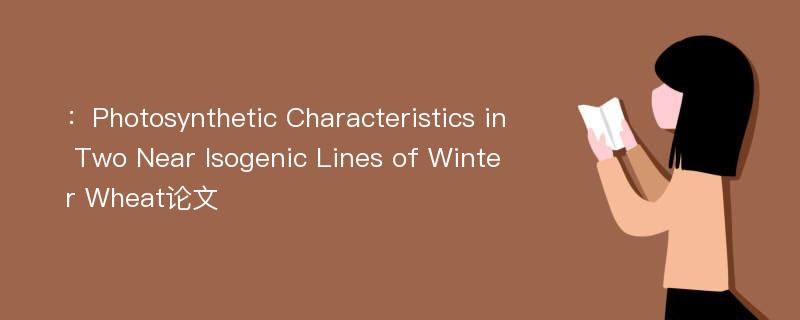
本文主要研究内容
作者(2019)在《Photosynthetic Characteristics in Two Near Isogenic Lines of Winter Wheat》一文中研究指出:The development of near isogenic lines(NILs) is an important tool for physiological dissection of drought resistance in wheat. To better understand the potential for improving grain yield, a split-plot experiment was conducted under a mobile rain shelter using NILs of winter wheat with significant differences in the photosynthetic rate: the 908120 line with a high photosynthetic rate and the 908206 line with a low photosynthetic rate. The results indicated that the net photosynthesis rate(Pn), stomatal conductance, and transpiration rate in flag leaves in line 908120 were significantly higher than that in line 908206 under uniform water treatments during the reproductive phase in replicated pooled-culture trials. The maximum quantum yield Fv/Fm value and ribulose-1,5-bisphosphate carboxylase/oxygenase(RuBPCase) activity value were higher in line 908120 than that in line 908206, whereas the intercellular CO2 and cell membrane permeability in line 908120 were lower than that in line 908206. Higher leaf Pn, transpiration rate, and RuBPCase activity and lower membrane ion leakage rate ensured the robustness of line 908120 during times of irrigation and drought, which contributed to the maintenance of its high grain yield. Drought had a negative effect on these factors, resulting in decreased yield, and the photosynthesis rate of flag leaves markedly affected the yield in NILs of winter wheat. NILs are an important strategy for wheat adaptation to drought stress, but might not be the only mechanism causing the significant grain yield increase. Collectively, the characteristics of line 908120 resulted in a higher grain yield compared with that of line 908206. Further dissection of the drought avoidance mechanisms in wheat, as well as analysis and identification of the genes involved may be necessary.
Abstract
The development of near isogenic lines(NILs) is an important tool for physiological dissection of drought resistance in wheat. To better understand the potential for improving grain yield, a split-plot experiment was conducted under a mobile rain shelter using NILs of winter wheat with significant differences in the photosynthetic rate: the 908120 line with a high photosynthetic rate and the 908206 line with a low photosynthetic rate. The results indicated that the net photosynthesis rate(Pn), stomatal conductance, and transpiration rate in flag leaves in line 908120 were significantly higher than that in line 908206 under uniform water treatments during the reproductive phase in replicated pooled-culture trials. The maximum quantum yield Fv/Fm value and ribulose-1,5-bisphosphate carboxylase/oxygenase(RuBPCase) activity value were higher in line 908120 than that in line 908206, whereas the intercellular CO2 and cell membrane permeability in line 908120 were lower than that in line 908206. Higher leaf Pn, transpiration rate, and RuBPCase activity and lower membrane ion leakage rate ensured the robustness of line 908120 during times of irrigation and drought, which contributed to the maintenance of its high grain yield. Drought had a negative effect on these factors, resulting in decreased yield, and the photosynthesis rate of flag leaves markedly affected the yield in NILs of winter wheat. NILs are an important strategy for wheat adaptation to drought stress, but might not be the only mechanism causing the significant grain yield increase. Collectively, the characteristics of line 908120 resulted in a higher grain yield compared with that of line 908206. Further dissection of the drought avoidance mechanisms in wheat, as well as analysis and identification of the genes involved may be necessary.
论文参考文献
论文详细介绍
论文作者分别是来自Agricultural Biotechnology的,发表于刊物Agricultural Biotechnology2019年02期论文,是一篇关于,Agricultural Biotechnology2019年02期论文的文章。本文可供学术参考使用,各位学者可以免费参考阅读下载,文章观点不代表本站观点,资料来自Agricultural Biotechnology2019年02期论文网站,若本站收录的文献无意侵犯了您的著作版权,请联系我们删除。
